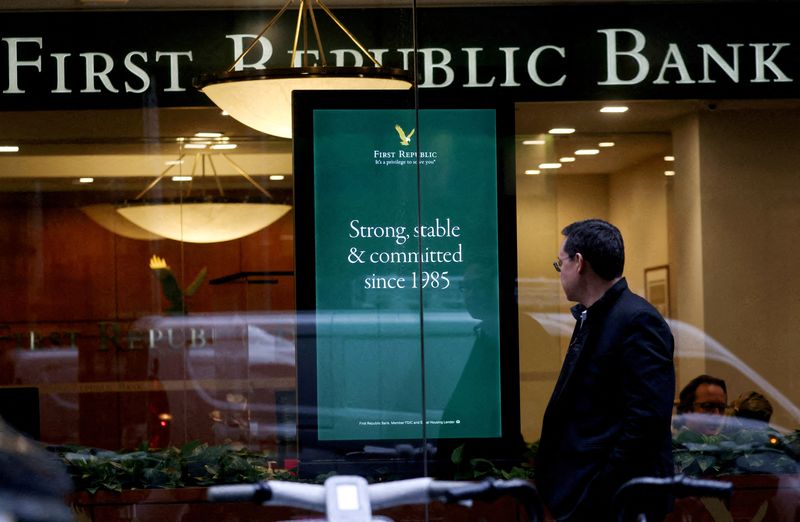By Nupur Anand, Andrea Shalal and Greg Roumeliotis
NEW YORK (Reuters) - U.S. officials are coordinating urgent talks to rescue First Republic Bank (NYSE:FRC) as private-sector efforts led by the bank's advisers have yet to reach a deal, according to three sources familiar with the situation.
The Federal Deposit Insurance Corporation (FDIC), the Treasury Department and the Federal Reserve are among government bodies that have in recent days started to orchestrate meetings with financial companies about putting together a solution for the troubled lender, the sources said.
While the government has been in contact with First Republic and its advisers for weeks, its new involvement is helping bring more parties, including banks and private equity firms, to the negotiating table, one of the sources added.
It is unclear whether the U.S. government is considering participating in a private-sector rescue of First Republic. The government's engagement, however, has emboldened First Republic executives as they scramble to put together a deal that would avoid a takeover by U.S. regulators, one of the sources said.
First Republic became the epicenter of the U.S. regional banking crisis in March after the wealthy clients it courted to fuel its breakneck growth started withdrawing deposits and left the bank reeling.
U.S. officials view a private-sector deal as preferable to First Republic falling into FDIC receivership, two of the sources said.
But many of the options proposed - including selling assets or the creation of a "bad bank" that would isolate its underwater assets - have so far failed to yield a deal, the sources added.
Any solution would have to come with coverage for the losses First Republic or a potential acquirer of the bank would assume if there was a transaction. These losses would stem from First Republic's loan book and fixed-income portfolio, whose low-yielding assets would be marked down to account for a rise in interest rates.
The deal structure that stands the best chance of rescuing First Republic is a special purpose vehicle that would carve out some of the lender's assets for other banks to buy, two sources familiar with the discussions said.
Banks have been reluctant to purchase these assets at a market discount, and First Republic is hoping that U.S. officials can convince them to participate or provide some kind of government backstop for a deal, one of the sources said.
CNBC reported on Friday, citing sources, that the government talks are now focused on preparing to put First Republic into FDIC receivership, and that such an outcome was likely. In receivership, an FDIC fund would assume any losses incurred through taking over First Republic's underwater assets. The FDIC would then recoup those losses from all the banks contributing to its insurance scheme, without a hit on U.S. taxpayers.
The sources requested anonymity because the discussions are confidential.
"We are engaged in discussions with multiple parties about our strategic options while continuing to serve our clients," First Republic said in a statement.
The Treasury Department, Federal Reserve and FDIC declined to comment.
First Republic shares were trading down 30% to $4.31 on Friday.
Wall Street banks have been trying to find a solution for First Republic since 11 of the biggest U.S. lenders deposited $30 billion at the bank on March 16 to stanch a regional banking crisis that led to the failure of Silicon Valley Bank and Signature Bank (OTC:SBNY).

Discussions for a deal took on new urgency this week after First Republic on Monday revealed it had deposit outflows of more than $100 billion in the first quarter. Although the bank said its deposits had stabilized, it disclosed that it was losing money because it had to replace the withdrawn deposits with interest-bearing funding from the Federal Reserve.
First Republic is contemplating a major hit, and even a total loss for shareholders, as part of the options that would prevent U.S. regulators from taking it over, one of the sources said. First Republic shares have lost 95% of their value since the regional banking crisis started on March 8.